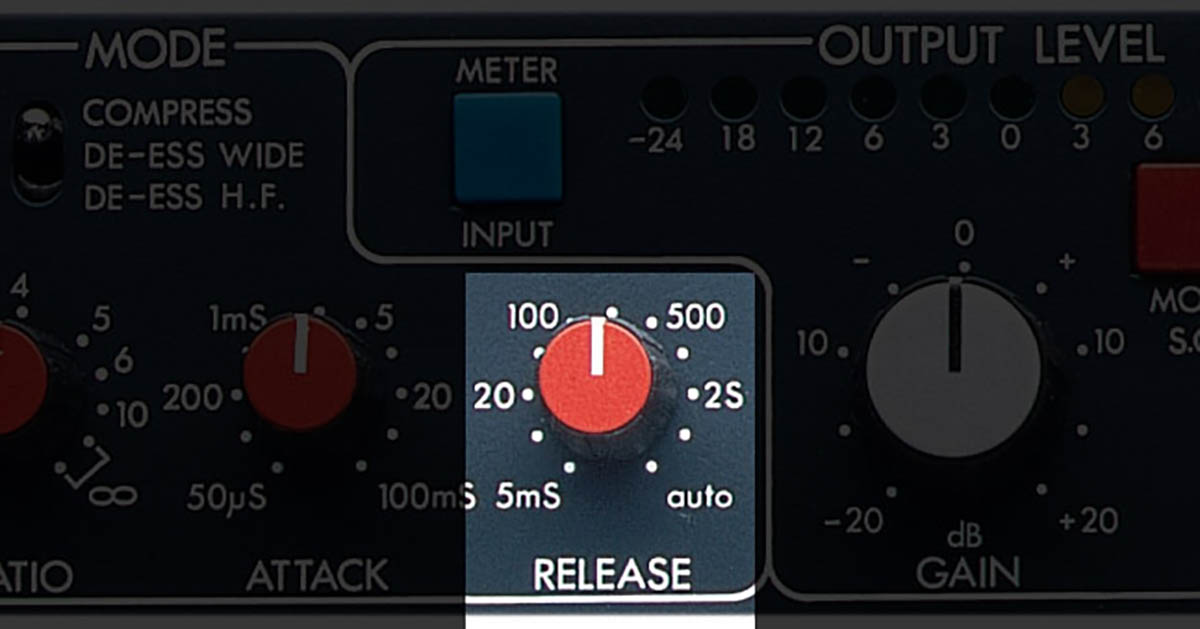Audio compressor controls: The release control

I have covered the ratio and threshold controls already, and it is fair to say that you won't get far with compression without a good understanding of what these controls do.
But with that knowledge in place, I believe it is fair to say that the release control is the 'heart' of the compressor. With the ratio and threshold controls set to appropriate values, it is the release control that sets the subjective amount of compression.
Dynamics
It is vital to understand that compression is a dynamic process, in the sense that it constantly changes the signal. You can change the level of a signal by changing the position of the channel (track) fader. But if the fader stays where you put it, then the level change is completely static.
A compressor on the other hand constantly analyzes the signal level and changes the gain to bring down the level when it is high, and leave it alone when it is low (i.e. below the threshold level).
As the signal changes in level above the threshold, the compressor is making constant changes and hence we can consider it a dynamic process.
Release
The release control sets the time the compressor takes to react to a signal level that is falling. So suppose the signal level is above the threshold and the compressor works to bring it down in level. Then it falls below the threshold and the compressor returns to its 1:1 uncompressed state. There will be a certain reaction time for this change to happen, and that is set by the release control.
Suppose the release control is set to a very long duration, say 2 seconds (2000 milliseconds), which is the longest release time that is calibrated in the compressor shown above, which is the BSS Audio DPR 402 if you want to research this model further.
With the release time set to 2 seconds, it will take around that long for the compressor to recover after the signal falls below the threshold level. But suppose the signal returns above the threshold before 2 seconds have elapsed? The compressor will not have time to return to zero compression.
In practice is is often possible to set a release time that is long enough that the compressor never returns to zero compression. Hence the result is much more like steady-state, and almost becomes a pure level reduction, as you could have applied with a fader.
So...
A long release time means that there is less compression.
Want more compression?
The purpose of using a compressor is to apply compression. So if setting a long release time results in less subjective compression, then it follows that setting a short release time results in more subjective compression.
Setting a short release time means that the compressor is more active, changing the signal level more of the time and faster. So you get more subjective compression, or in other words the signal sounds more compressed to the ear.
At very short release times, this becomes perfectly easy to hear. Of course, there may be a point where the action of the compressor is too obvious, which would indicate that the release time is too short.
How to set the release time
At the risk of seeming like trying to explain how to play the violin in a couple of sentences, I would say this about setting the release time...
Start with a moderately short release, say 100 milliseconds. Set the ratio and threshold controls to your liking. Then reduce the release time until you don't like what you hear. Then reconsider the ratio and threshold again because all of the controls of the compressor need to work in synergy.
But if the compression effect is too obvious for your liking at 100 milliseconds, increase the release time until you hear the sound that you want. Of course, the best release time will vary considerably depending on the nature of the signal you are compressing.
Don't forget that the designer of the compressor has provided a full range of release times for you to use, so don't be afraid of using either the minimum or maximum if it suits your purpose and sounds good.
One more thing...
On the compressor illustrated you will see an 'auto' setting for release. This will be explained in a further article in this series.
The release control of the compressor is covered in detail in Module 4 of the Audio Masterclass Music Production and Sound Engineering Course, and also in the Audio Masterclass Professional Course in Compression.






























